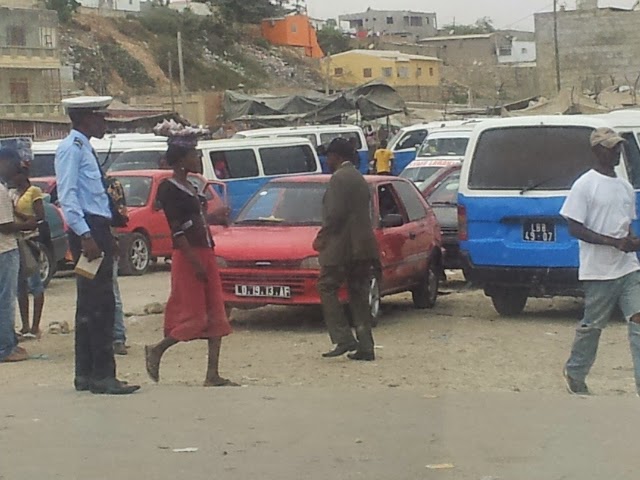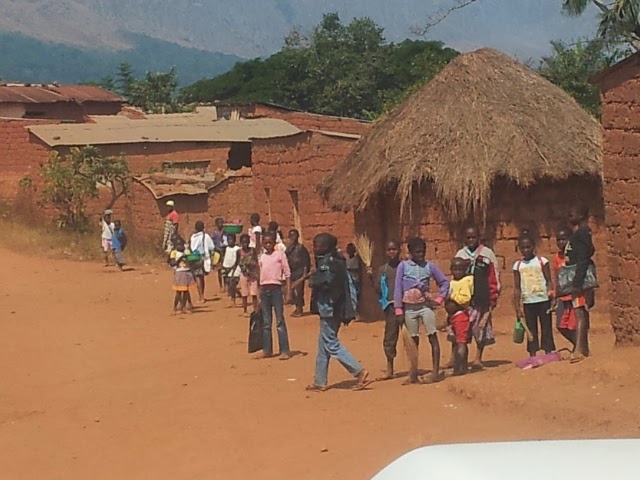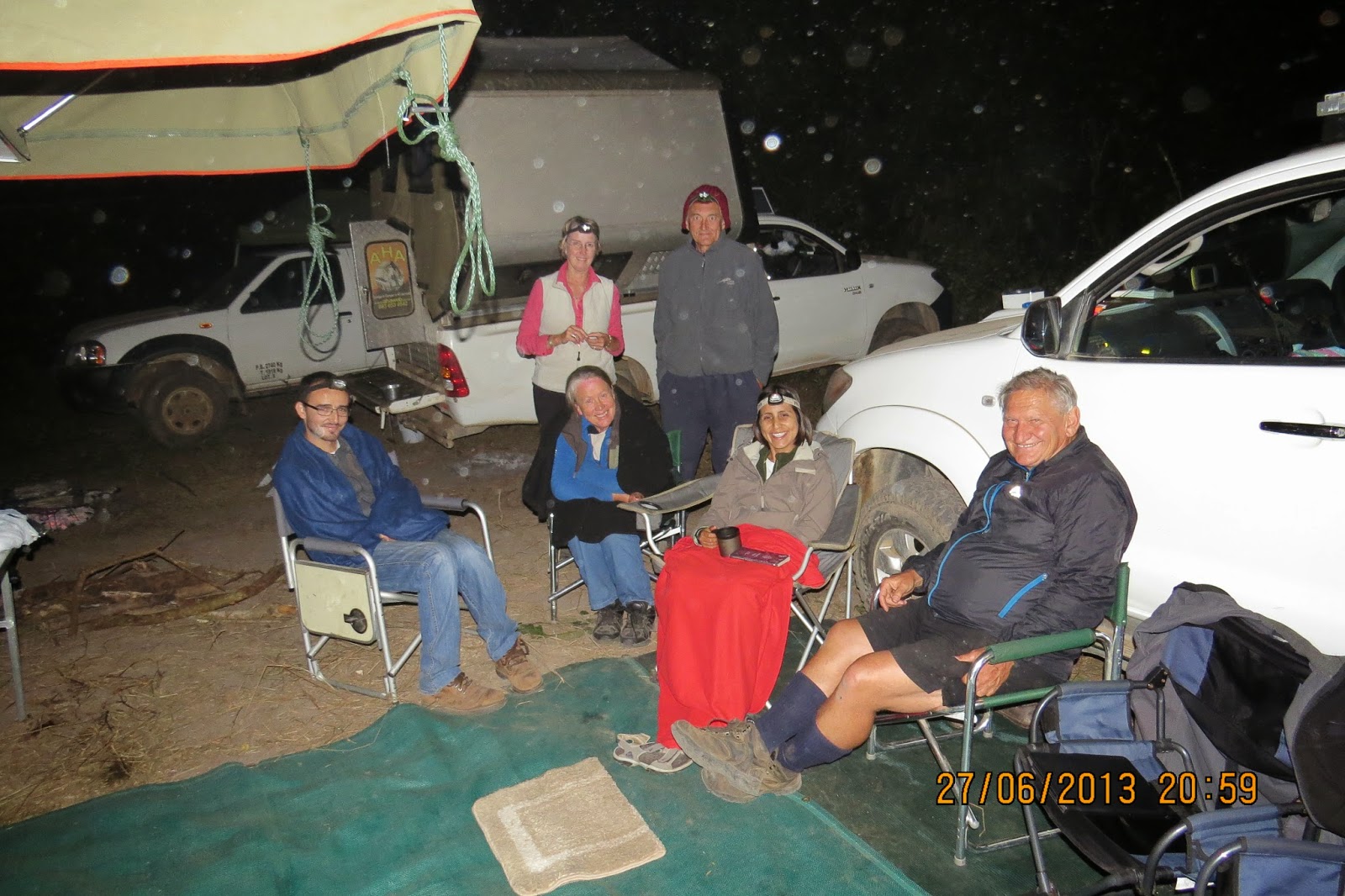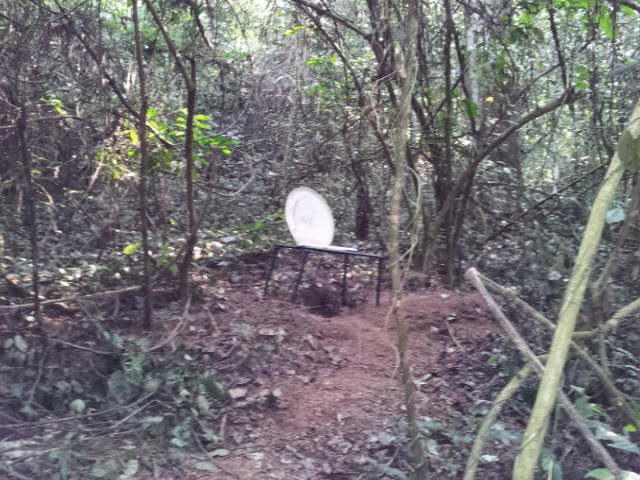Our destinations:
- Sumbe to renew our visas and
- Kumbira Forest to watch birds with Aimy Cacares.
D20 (25.6.2013, Zulu Restaurant (30 km S of Lobito) - Wembele Restaurant (30 km S of Sumbe, 185 km)
We said goodbye to Zulu Restaurant which is closed on a Monday and hadn't opened yet when we left on the Tuesday, but the flush toilets and running water had made it OK to camp there.We wanted to buy the Angolan flag which hung above this man's stall, but he refused and instead presented us with this small flag as a gift.
We drove through Lobito on our way towards Sumbe.
However, no visit to a town is complete without stopping to replenish our stocks.
On the outskirts of town the standard of living drops: more people and more houses.
A wreck once again warns us to be careful on the roads.
North from Lobito, we turned off towards the village Kikombe where slaves were hoarded together waiting for transport across the sea to Portuguese colonies in South America. A fort bears witness to past cruelties.
Kikombe is a fishing village. This dried fish was packed into large bags ready for sale. We chose to buy a freshly salted fish for supper. Fortunately the seller was willing to chop its head off to make transporting the enormous fish possible.
Freshly salted fish being taken to the city.
Euphorbia along the road.
Cubal River Gorge through which the Rio Cubal flows - magnificent!
It was getting late. Fortunately we found Restaurante Wembele which (to our surprize) had brand new camping facilities behind it. The restaurant is about 30 km south of Sumbe.
What better to enjoy a Cuca (beer) on the beach in a safe camping site.
D21 (26.6.2013, Wembele Restaurant (Sumbe) - Conda, 137km)
From Wembele (+- 30km south of Sumbe) we left in order to meet Aimy in Sumbe as arranged.These pink buildings were the first to greet us in Sumbe. Probably Chinese? Generally, pink buildings signified government buildings. Could these be accommodation for government employees?
Another Chinese influence? Dust masks for street sweepers.
The church near our meeting place with Aimy.
Our meeting place: lovely coffee! This is where Aimy (standing on the right hand side in the photo) found us.
On her advice, we contacted the Department of Immigration where they helped us to plan the renewal of our visas and gave us the necessary form to fill out. Without Aimy's help we would never have managed because of the language barrier.
The outskirts of Sumbe - we were on our way to Kumbira forest.
We passed Binga Water Falls on our way into the forest. These children were playing next to the field where their mother was working. She was happy to have a photo taken of her children.
A Baobab forest.
The bridge across the Rio Keve which also formed the Binga Falls which we had passed earlier.
One of the many small villages we passed as we drove towards Kumbira Forest.
Even here in this precious scarp-forest (one of the last existing scraps of this type of forest in Angola), making charcoal and selling vegetables was a way to survive.
A view onto the mountains which house the forest.
At last we arrived at Conda and Aimy decided that we must sleep in this village as the road to her camping spot in the forest was a VERY SLOW road. Our guest house was the Hospedaria Petala where we had supper and camped in the enclosed back yard.
D22 (27.6.2013, Conda - Kumbira Forest, 14 km)
We left Conda to venture into the forest - luckily we could follow Aimy. Aimy is a young Peruvian doctoral student doing her research on the endemic birds of Angola.
Read more about Aimy's project on http://kumbiraforest.blogspot.com/.
Just look at the state of the road - but then, not many cars pass this way and its good enough for pedestrians, donkeys and tractors.
Brick making is done by women.
Forest morning mist and distant granite boulders.
An abandoned house - what stories could it tell?
A log bridge always sets the heart pounding.
Another village - we caused quite an uproar driving through their territory.
Then we found the track which took us to Aimy's camp site. The track seemed more suitable to pedestrians than cumbersome 4x4 vehicles. In the forest some small surprises waited for us - red flowers/leaves.
Aimy had cleared more space at her camp site so all three our vehicles fitted in very snugly.
The villagers' tracks to their village in the forest lead through our camping spot - or should I say, that we camped squarely on their tracks. However, they were always courteous, although inquisitive.
We did some birding with Aimy. We actually got a glimpse of the Angolan national bird, the Red-Crested Turaco.
Guess what we had for supper? We washed our fish well in order to make it less salty. We cooked it over our small fire and there was enough for Aimy and her research assistant, Ricardo Lima, to join us.
D23 (28.6.2013, Kumbira environs)
Our first full day in Kumbira Forest started in the mist-laden morning because Aimy and Ricardo had to be in the forest to track their radio-fitted birds. Mrad actually managed to see the Gabela Akalat and the Gabela Bush Shrike, but they were too fast for any photos.We left Aimy & Ricardo to focus on their task in hand and walked, binoculars in hand, back to our camp site. The forest offered us many sights. Mrad ended up with four lifers!
These are some sights which we enjoyed: our bush loo, children riding on a home-made wooden scooter, locals carrying home-grown produce.
Later that afternoon we walked to a massive granite rock near the camp site. Aimy had given us the coordinates. From the top of the boulder we looked over the forest canopy below and enjoyed the vegetation that flourished on top of the granite rock.
A fallen Baobab sprouting new branches.
Sunset reflected on tree stems - we knew we had to return home to our camp.
A bug that visited our camp site.
Thank you ever so much, Aimy, for sharing your small camp site with us!! We really appreciated it and it remains one of the highlights of our 44 nights in Angola!








































































Dit lyk na 'n fantastiese toer! 'n wonderlike avontuur!
ReplyDelete